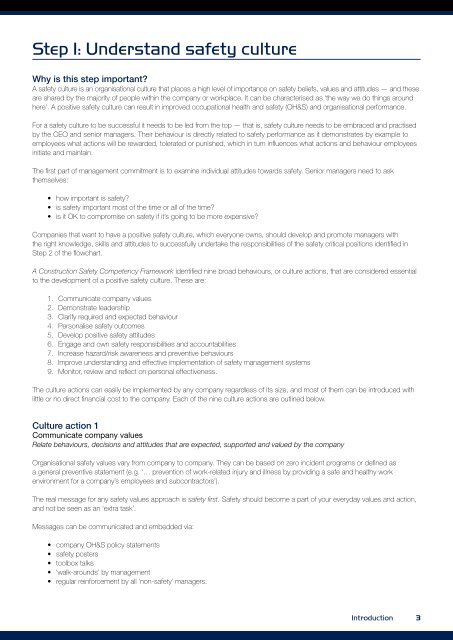A Practical Guide to Safety Leadership Book (PDF 5MB) - QUT ePrints
A Practical Guide to Safety Leadership Book (PDF 5MB) - QUT ePrints
A Practical Guide to Safety Leadership Book (PDF 5MB) - QUT ePrints
Create successful ePaper yourself
Turn your PDF publications into a flip-book with our unique Google optimized e-Paper software.
Step 1: Understand safety culture<br />
Why is this step important?<br />
A safety culture is an organisational culture that places a high level of importance on safety beliefs, values and attitudes — and these<br />
are shared by the majority of people within the company or workplace. It can be characterised as ‘the way we do things around<br />
here’. A positive safety culture can result in improved occupational health and safety (OH&S) and organisational performance.<br />
For a safety culture <strong>to</strong> be successful it needs <strong>to</strong> be led from the <strong>to</strong>p — that is, safety culture needs <strong>to</strong> be embraced and practised<br />
by the CEO and senior managers. Their behaviour is directly related <strong>to</strong> safety performance as it demonstrates by example <strong>to</strong><br />
employees what actions will be rewarded, <strong>to</strong>lerated or punished, which in turn influences what actions and behaviour employees<br />
initiate and maintain.<br />
The first part of management commitment is <strong>to</strong> examine individual attitudes <strong>to</strong>wards safety. Senior managers need <strong>to</strong> ask<br />
themselves:<br />
• how important is safety?<br />
• is safety important most of the time or all of the time?<br />
• is it OK <strong>to</strong> compromise on safety if it’s going <strong>to</strong> be more expensive?<br />
Companies that want <strong>to</strong> have a positive safety culture, which everyone owns, should develop and promote managers with<br />
the right knowledge, skills and attitudes <strong>to</strong> successfully undertake the responsibilities of the safety critical positions identified in<br />
Step 2 of the flowchart.<br />
A Construction <strong>Safety</strong> Competency Framework identified nine broad behaviours, or culture actions, that are considered essential<br />
<strong>to</strong> the development of a positive safety culture. These are:<br />
1. Communicate company values<br />
2. Demonstrate leadership<br />
3. Clarify required and expected behaviour<br />
4. Personalise safety outcomes<br />
5. Develop positive safety attitudes<br />
6. Engage and own safety responsibilities and accountabilities<br />
7. Increase hazard/risk awareness and preventive behaviours<br />
8. Improve understanding and effective implementation of safety management systems<br />
9. Moni<strong>to</strong>r, review and reflect on personal effectiveness.<br />
The culture actions can easily be implemented by any company regardless of its size, and most of them can be introduced with<br />
little or no direct financial cost <strong>to</strong> the company. Each of the nine culture actions are outlined below.<br />
Culture action 1<br />
Communicate company values<br />
Relate behaviours, decisions and attitudes that are expected, supported and valued by the company<br />
Organisational safety values vary from company <strong>to</strong> company. They can be based on zero incident programs or defined as<br />
a general preventive statement (e.g. ‘… prevention of work-related injury and illness by providing a safe and healthy work<br />
environment for a company’s employees and subcontrac<strong>to</strong>rs’).<br />
The real message for any safety values approach is safety first. <strong>Safety</strong> should become a part of your everyday values and action,<br />
and not be seen as an ‘extra task’.<br />
Messages can be communicated and embedded via:<br />
• company OH&S policy statements<br />
• safety posters<br />
• <strong>to</strong>olbox talks<br />
• ‘walk-arounds’ by management<br />
• regular reinforcement by all ‘non-safety’ managers.<br />
Introduction 3

















